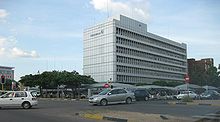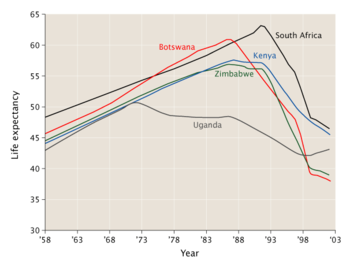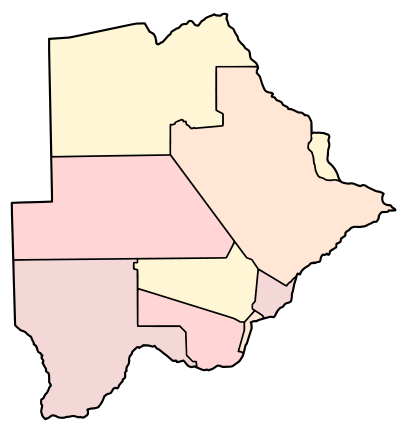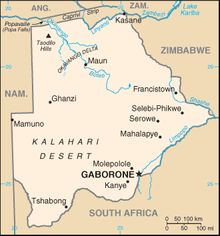
Botswana
Background Information
SOS Children produced this website for schools as well as this video website about Africa. Do you want to know about sponsoring? See www.sponsorachild.org.uk
| Republic of Botswana Lefatshe la Botswana ( Tswana)
|
||||||
|---|---|---|---|---|---|---|
|
||||||
| Motto: "Pula" (Tswana) "Rain" |
||||||
| Anthem: Fatshe leno la rona (Tswana) This Land of Ours |
||||||
|
Location of Botswana (dark blue)
– in Africa (light blue & dark grey) |
||||||
| Capital and largest city |
Gaborone 25°40′S 25°55′E |
|||||
| Official languages |
|
|||||
| Ethnic groups |
|
|||||
| Demonym |
|
|||||
| Government | Parliamentary republic | |||||
| - | President | Ian Khama | ||||
| - | Vice President | Ponatshego Kedikilwe | ||||
| Legislature | National Assembly | |||||
| Independence | ||||||
| - | from the United Kingdom | 30 September 1966 | ||||
| - | Current constitution | 30 September 1966 | ||||
| Area | ||||||
| - | Total | 581,730 km2 ( 48th) 224,610 sq mi |
||||
| - | Water (%) | 2.6 | ||||
| Population | ||||||
| - | 2010 estimate | 2,029,307 ( 144th) | ||||
| - | 2001 census | 1,680,863 | ||||
| - | Density | 3.4/km2 ( 229th) 8.9/sq mi |
||||
| GDP ( PPP) | 2011 estimate | |||||
| - | Total | $29.707 billion | ||||
| - | Per capita | $16,029 | ||||
| GDP (nominal) | 2011 estimate | |||||
| - | Total | $17.570 billion | ||||
| - | Per capita | $9,480 | ||||
| Gini (1993) | 63 very high |
|||||
| HDI (2010) | medium · 98th |
|||||
| Currency | Pula ( BWP) |
|||||
| Time zone | Central Africa Time ( UTC+2) | |||||
| - | Summer ( DST) | not observed ( UTC) | ||||
| Drives on the | left | |||||
| Calling code | +267 | |||||
| ISO 3166 code | BW | |||||
| Internet TLD | .bw | |||||
Botswana, officially the Republic of Botswana ( Tswana: Lefatshe la Botswana), is a landlocked country located in Southern Africa. The citizens refer to themselves as "Batswana" (singular: Motswana), but many English-language sources use "Botswanan" instead. Formerly the British protectorate of Bechuanaland, Botswana adopted its new name after becoming independent within the Commonwealth on 30 September 1966. It has held free and fair democratic elections since independence.
Botswana is flat, and up to 70% is covered by the Kalahari Desert. It is bordered by South Africa to the south and southeast, Namibia to the west and north, and Zimbabwe to the northeast. Its border with Zambia to the north near Kazungula, Zambia is poorly defined but at most is a few hundred meters long.
A mid-sized country of just over two million people, Botswana is one of the most sparsely populated countries in the world. Botswana was one of the poorest countries in Africa when it gained independence from the United Kingdom in 1966, with a GDP per capita of about US$70. Botswana has since transformed itself, becoming one of the fastest-growing economies in the world to a GDP (purchasing power parity) per capita of about $14,000, and a high gross national income, possibly the fourth-largest in Africa, giving the country a modest standard of living. The country also has a strong tradition as a representative democracy.
Politics and government
The politics of Botswana take place in a framework of a representative democratic republic, whereby the President of Botswana is both head of state and head of government, and of a multi-party system. Executive power is exercised by the government. Legislative power is vested in both the government and the Parliament of Botswana. The most recent election, its tenth, was held on 16 October 2009.
Since independence was declared, the party system has been dominated by the Botswana Democratic Party. The judiciary is independent of the executive and the legislature. According to Transparency International, Botswana is the least corrupt country in Africa and ranks similarly close to Portugal and South Korea. Nevertheless the country is considered to have the most secretive public institutions in Africa. The national anthem is Fatshe leno la rona.
Administrative divisions
Botswana is divided into 9 districts.
Botswana is further divided into 15 councils which includes the 10 districts councils from the 10 districts plus some councils from urban or town councils being:
|
District |
Geography

At 581,730 km2 (224,607 sq mi) Botswana is the world's 48th-largest country (after Madagascar). It is comparable in size to Madagascar, and is slightly smaller than the U.S. state of Texas or the Canadian province of Manitoba. It lies between latitudes 17° and 27°S, and longitudes 20° and 30°E.
The country is predominantly flat, tending toward gently rolling tableland. Botswana is dominated by the Kalahari Desert, which covers up to 70% of its land surface. The Okavango Delta, one of the world's largest inland deltas, is in the northwest. The Makgadikgadi Pan, a large salt pan, lies in the north.
The Limpopo River Basin, the major landform of all of southern Africa, lies partly in Botswana, with the basins of its tributaries, the Notwane, Bonwapitse, Mahalapswe, Lotsane, Motloutse and the Shashe, located in the eastern part of the country. The Notwane provides water to the capital through the Gaborone Dam. The Chobe River lies to the north, providing a boundary between Botswana and Namibia, in the Caprivi Region. The Chobe River meets with the Zambezi River at a place called Kazungula (meaning a small sausage tree, a point where Sebitwane and his Makololo tribe crossed the Zambezi into Zambia).
Ecology
Botswana has diverse areas of wildlife habitat. In addition to the delta and desert areas, there are grasslands and savannas, where Blue Wildebeest, antelopes, and other mammals and birds are found. Northern Botswana has one of the few remaining large populations of the endangered African Wild Dog. Chobe National Park, found in the Chobe District, has the world's largest concentration of African elephants. The park covers about 11,000 km2 (4,247 sq mi) and supports about 350 species of birds.
The Chobe National Park and Moremi Game Reserve (in the Okavango Delta) are major tourist destinations. Other reserves include the Central Kalahari Game Reserve located in the Kalahari desert in Ghanzi District; Makgadikgadi Pans National Park and Nxai Pan National Park are in Central District in the Makgadikgadi Pan. Mashatu Game Reserve is privately owned: located where the Shashe River and Limpopo River meet in eastern Botswana. The other privately owned reserve is Mokolodi Nature Reserve near Gaborone. There are also specialised sanctuaries like the Khama Rhino Sanctuary (for Rhinoceros) and Makgadikgadi Sanctuary (for Flamingos). They are both located in Central District.
Environmental problems
Botswana faces two major environmental problems: drought and desertification. The desertification problems predominantly stem from the severe times of drought in the country. Three quarters of the country’s human and animal populations depend on groundwater due to drought. Groundwater use has eased the effects of drought but has taken a toll on the land. Groundwater is retrieved through drilling deep boreholes which leads to the erosion of the land. Surface water is scarce in Botswana and less than 5% of the agriculture in the country is sustainable by rainfall. Due to this 95% of the country raises cattle and livestock as a means for an income. Approximately 71% of the country’s land is used for communal grazing, which has been a major cause of the desertification of the country.
Since raising livestock has proven to be profitable for the people of Botswana, the land continues to be exploited. The animal populations have continued to dramatically increase. From 1966 to 1991 the livestock population has increased from 1.7 million to 5.5 million. Similarly, the human population has increased from 574,000 in 1971 to 1.5 million in 1995, nearly a 200% increase. “Over 50% of all households in Botswana own cattle, which is currently the largest single source of rural income”. “Rangeland degradation or desertification is regarded as the reduction in land productivity as a result of overstocking and overgrazing or as a result of veld product gathering for commercial use. Degradation is exacerbated by the effects of drought and climate change”. Environmentalists report that the Okavango Delta is drying up due to the increased grazing of livestock. The Okavango Delta is one of the major semi-forested wetlands in Botswana and one of the largest inland deltas in the world; it is a crucial ecosystem to the survival of many animals.
The Department of Forestry and Range Resources has already begun to implement a project to reintroduce indigenous vegetation into communities in Kgalagadi South, Kweneng North and Boteti. Reintroduction of indigenous vegetation will help with the degradation of the land. The United States Government has also entered into an agreement with Botswana, giving them $7 million US dollars to reduce Botswana’s debt by $8.3 million US dollars. The stipulation of the US reducing Botswana’s debt is that Botswana will focus on more extensive conservation of the land.
The United Nations Development Programme claims that poverty is a major problem behind the overexploitation of resources, including land, in Botswana. To help change this the UNDP joined in with a project started in the southern community of Struizendam in Botswana. The purpose of the project is to draw from “indigenous knowledge and traditional land management systems”. The leaders of this movement are supposed to be the people in the community, to draw them in, in turn increasing their possibilities to earn an income and thus decreasing poverty. The UNDP also stated that the government has to effectively implement policies to allow people to manage their own local resources and are giving the government information to help with policy development
Foreign relations and military
At the time of independence, Botswana had no armed forces. It was only after the Rhodesian and South African militaries struck respectively against ZIPRA and MK bases that the Botswana Defence Force (BDF) was formed in 1977. The president is commander in chief and appoints a defence council. The BDF has approximately 12,000 members.
Following political changes in South Africa and the region, the BDF's missions have increasingly focused on prevention of poaching, preparing for disasters, and foreign peacekeeping. The United States has been the largest single foreign contributor to the development of the BDF, and a large segment of its officer corps has received U.S. training. It is considered an apolitical and professional institution.
The Botswana government gave the United States the green light to explore the possibility of establishing an Africa Command (Africom) base in the country. This fueled protests by the South African ANC youth organization.
Economy


The Bank of Botswana serves as a central bank in order to develop and maintain the Botswana pula, the country's currency. Since independence, Botswana has had one of the fastest growth rates in per capita income in the world. Botswana has transformed itself from one of the poorest countries in the world to a middle-income country. By one estimate, it has the fourth highest gross national income at purchasing power parity in Africa, giving it a standard of living around that of Mexico and Turkey.
According to the International Monetary Fund, economic growth averaged over 9% per year from 1966 to 1999. Botswana has a high level of economic freedom compared to other African countries. The government has maintained a sound fiscal policy, despite consecutive budget deficits in 2002 and 2003, and a negligible level of foreign debt. It earned the highest sovereign credit rating in Africa and has stockpiled foreign exchange reserves (over $7 billion in 2005/2006) amounting to almost two and a half years of current imports.
An array of financial institutions populates the country’s financial system, with pension funds and commercial banks being the two most important segments by asset size. Banks remain profitable, well-capitalized, and liquid, as a result of growing national resources and high interest rates.
Botswana’s competitive banking system is one of Africa’s most advanced. Generally adhering to global standards in the transparency of financial policies and banking supervision, the financial sector provides ample access to credit for entrepreneurs. The opening of Capital Bank in 2008 brought the total number of licensed banks to eight. The government is involved in banking through state-owned financial institutions and a special financial incentives program that is aimed at increasing Botswana’s status as a financial centre. Credit is allocated on market terms, although the government provides subsidized loans. Reform of non-bank financial institutions has continued in recent years, notably through the establishment of a single financial regulatory agency that provides more effective supervision. The government has abolished exchange controls, and with the resulting creation of new portfolio investment options, the Botswana Stock Exchange is growing.
The constitution prohibits the nationalization of private property and provides for an independent judiciary, and the government respects this in practice. The legal system is sufficient to conduct secure commercial dealings, although a serious and growing backlog of cases prevents timely trials. The protection of intellectual property rights has improved significantly. Botswana is ranked second only to South Africa among sub-Saharan Africa countries in the 2009 International Property Rights Index.
While generally open to foreign participation in its economy, Botswana reserves a number of sectors for citizen participation. Increased foreign investment plays a significant role in the privatization of state-owned enterprises. Investment regulations are transparent, and bureaucratic procedures are streamlined and open, although somewhat slow. Investment returns such as profits and dividends, debt service, capital gains, returns on intellectual property, royalties, franchise's fees, and service fees can be repatriated without limits.
Gemstones and precious metals
Debswana, the largest diamond mining company operating in Botswana, is 50% owned by the government. The mineral industry provides about 40% of all government revenues. In 2007, significant quantities of uranium were discovered, and mining was projected to begin by 2010. Several international mining corporations have established regional headquarters in Botswana, and prospected for diamonds, gold, uranium, copper, and even oil, many coming back with positive results. Government announced in early 2009 that they would try to shift their economic dependence on diamonds, over serious concern that diamonds are predicted to dry out in Botswana over the next twenty years.
Infrastructure
Energy
Botswana imports refined petroleum products and electricity from South Africa. There is some domestic production of electricity from coal. In spite of one the highest insolation levels in the world, Botswana has no significant solar energy capacity.
Health
Life expectancy at birth was 55 in 2009 according to the World Bank, having previously fallen from a peak of 64.1 in 1990 to a low of 49 in 2002.
HIV/AIDS

Like elsewhere in Sub-Saharan Africa, the economic impact of AIDS is considerable. Economic development spending was cut by 10% in 2002–3 as a result of recurring budget deficits and rising expenditure on healthcare services. Botswana has been hit very hard by the AIDS pandemic; in 2006 it was estimated that life expectancy at birth had dropped from 65 to 35 years.
The prevalence of HIV/AIDS in Botswana was estimated at 24% for adults in 2006. In 2003, the government began a comprehensive program involving free or cheap generic anti-retroviral drugs as well as an information campaign designed to stop the spread of the virus. Under the leadership of Festus Mogae, the Government of Botswana solicited outside help in fighting HIV/AIDS and received early support from the Bill and Melinda Gates Foundation, the Merck Foundation, and together formed the African Comprehensive HIV AIDS Partnership (ACHAP). Other early partners include the Botswana-Harvard AIDS Institute, of the Harvard School of Public Health and the Botswana-UPenn Partnership of the University of Pennsylvania. According to the 2011 UNAIDS Report, universal access to treatment – as defined as 80% coverage or greater – has been achieved in Botswana.
Concurrent sexual partnerships, transactional sex, cross-generational sex, and a significant numbers of people who have traveled outside of their local communities in pursuit of work, are potential reasons for the high HIV prevalence. The promiscuous nature of many sexual relationships further impacts the health situation; so much so that it has given rise to a Love Vocabulary that is unique to the region.
Approximately one in six Batswana has HIV, giving Botswana the second highest infection rate in the world after nearby Swaziland. The government recognizes that AIDS will affect the economy and is trying to combat the epidemic, including free anti-retroviral drug treatment and a nation-wide Prevention of Mother-to-Child Transmission program. Botswana has reduced HIV transmission from infected mothers to their children from about 40% to just 4%.
Cancer
The Cancer Association of Botswana is a voluntary non-governmental organization. The association is a member of the Union for International Cancer Control. The Association supplements existing services through provision of cancer prevention and health awareness programmes, facilitating access to health services for cancer patients and offering support and counseling to those affected.



![Location of Botswana (dark blue)– in Africa (light blue & dark grey)– in the African Union (light blue) — [Legend]](../../images/1704/170442.png)









